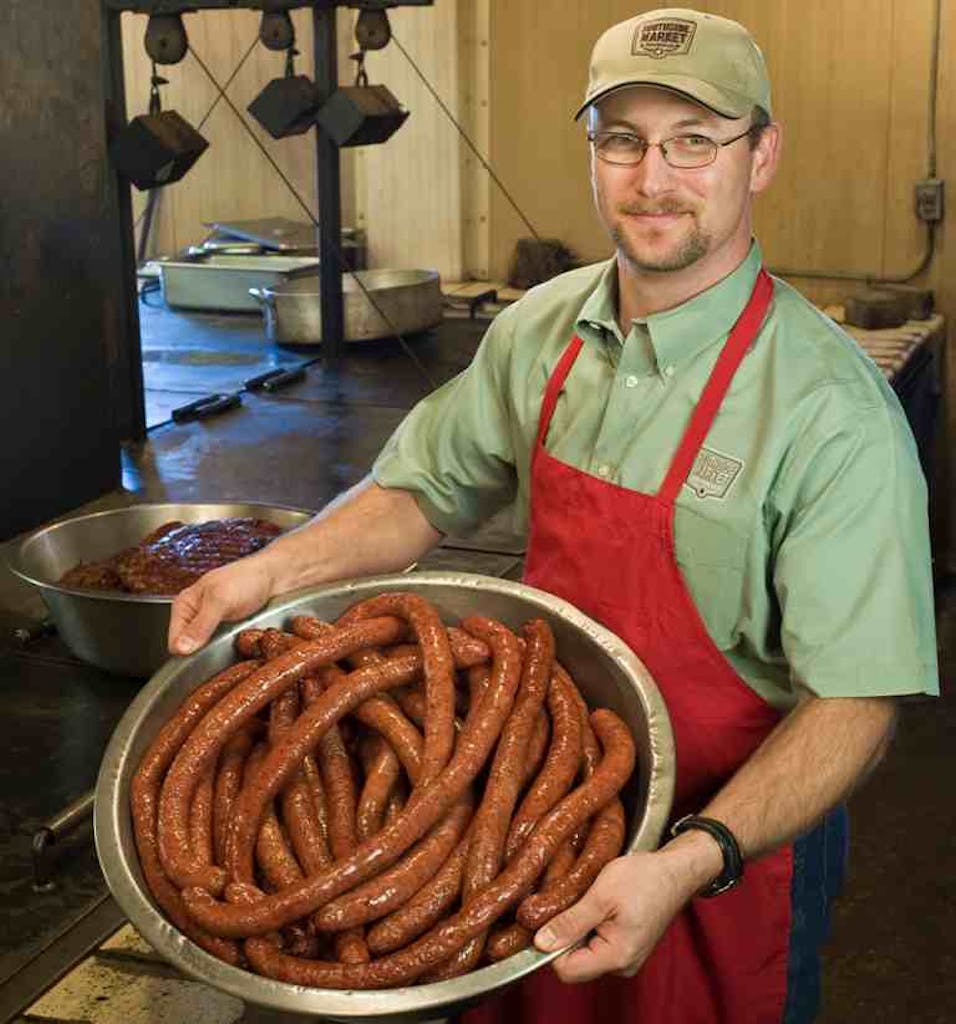
Owner: Southside Market, opened 1886
Age: 38
Smoker: Wood-fired rotisserie smokers and wood-fired brick pit
Wood: Post Oak
More than eight decades after it opened, Ernest Bracewell bought Southside Market in Elgin in 1968. Bryan Bracewell is the third generation of the Bracewell family to run the joint, but he didn’t get the reins handed to him until he got a proper Aggie Education. I spoke to him while we both attended Brisket Camp on the Texas A&M Campus. At a picnic table sitting beside a few pits full of brisket, Bracewell shared some sausage knowledge. “In the store you can tell the natural pork casings from the collagen or cellulose casings because the natural casings have a curve to them.” In addition to the lesson in casings and some family history, he informed me of the newest venture in the works for Southside – a second location in Bastrop. It’ll be just the second location ever in the long history of Texas’s oldest operating barbecue joint.
Daniel Vaughn: Southside Market is the oldest barbecue joint in Texas. Who first opened it?
Bryan Bracewell: Southside Market was started in 1882 by a man named William Moon. He was a small town butcher that slaughtered beef, pigs, and lamb on a piece of property about a mile outside of town. He’d haul the fresh meat into Elgin and sell it door-to-door from a horse drawn buggy. The barbecue and sausage was just a derivative of having fresh meat and no refrigeration. If he wasn’t a good salesman that day, he had to smoke it or smell it. The history of our place is just that. A small town butcher that had to sell the whole carcass.
DV: Do you have any records of what Mr. Moon’s menu looked like back then?
BB: Not really. It was just an old time butcher shop. I don’t think they really smoked brisket. It was probably clod or chuck.
DV: So you think he was smoking more meat than just sausage?
BB: Yes. He was dealing with whole carcasses that he had to get rid of.
DV: When did Mr. Moon settle down into a building?
BB: In 1886 he moved onto Central Avenue in downtown Elgin. He sold barbecue in the back of the building. The business moved around to other buildings on that same block before it settled at 109 Central Avenue. It stayed there until 1992. My grandfather had outgrown the building downtown, so he moved out to the highway. Before the move to the highway, he bought every building on the city block. He was going to level them and build the new barbecue joint and sausage facility there in town. They were all historical buildings there, so some folks didn’t want to see those go away. They formed a historic district pretty quick so he couldn’t tear them down. That made him pretty angry. There was a bank along the highway that had closed down, so he bought the building and moved out there.
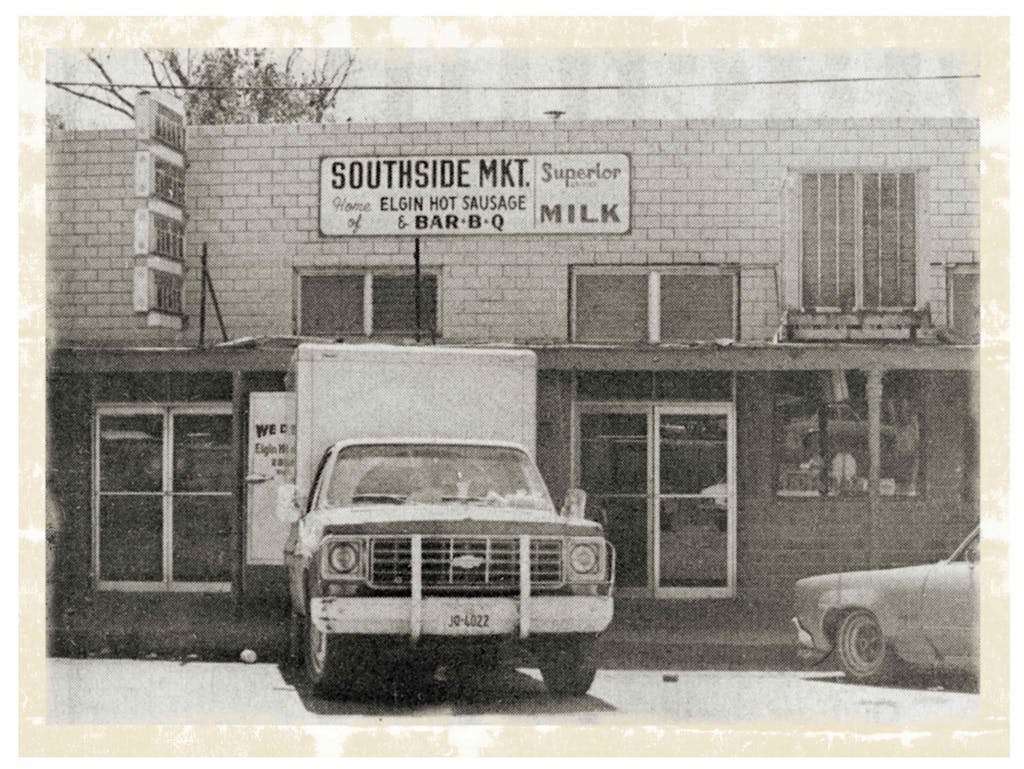
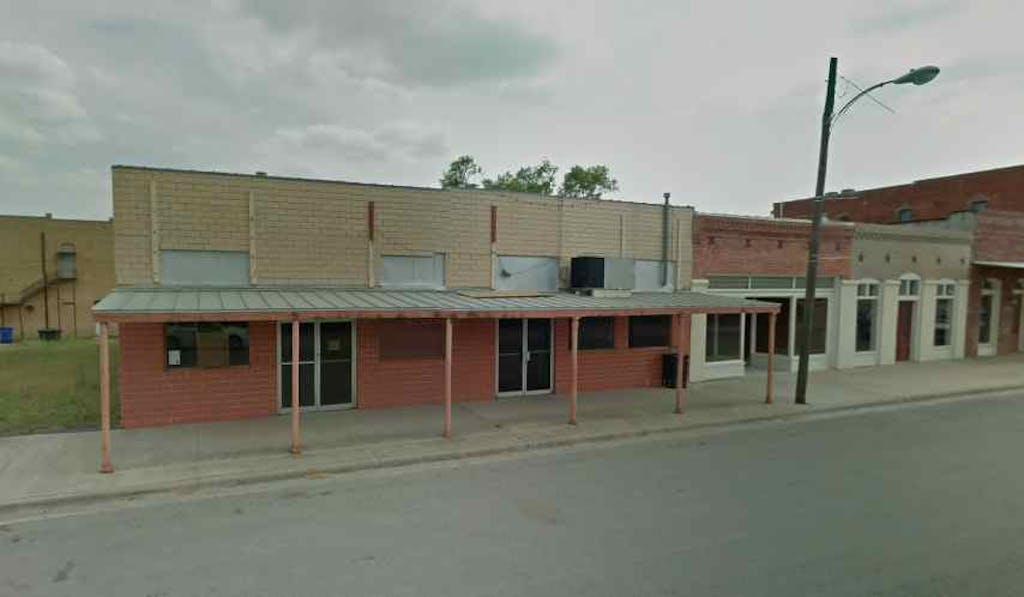
DV: Given the current traffic on Highway 290, that was probably the best thing that could have happened for business.
BB: It was a blessing in disguise, no doubt. That’s our lifeline. When the highway’s busy, we’re busy. We love our local patrons, but we feed whoever’s driving down 290. We do 75% of our business on Friday, Saturday, and Sunday.
DV: There’s a mythology about how many times Southside changed hands before it got into your family. Can you verify any of that?
BB: There were tales of the place changing hands back and forth in card games, but really, who the hell knows? My grandfather was the seventh owner of Southside when he bought it in 1968. He was a meat salesman before that and Southside was a customer.
DV: You’re the third generation in your family to run Southside Market, and the family has a pretty famous sausage recipe. When did you start making it yourself?
BB: I started when I was sixteen years old working summers in high school.
DV: When did they teach you the recipe?
BB: I learned the recipe when my dad and grandpa wanted to go hunting and left me at home by myself. That’s when I knew I was a man.
DV: They let you run the place at sixteen?
BB: No, no. That was after I graduated from Elgin High School and they shipped me off to Texas A&M for four years. That when Dr. Griffin and Dr. Savell learned me up pretty good. When I came back from college is when the real work started. I got back and hung around a little too long, so they put my butt to work. I’ve been there ever since.
DV: Was there any sort of ceremony where the recipe was passed down?
BB: I wish I had a sexy story, but in family business it just kinda happens that way. You show up and nobody else shows up, so you’re the man.
DV: When did your dad retire from the business?
BB: In family business you never use the word “retirement”, because as soon as I accused my dad or grandfather of retiring is when they’d get right up in my business.
DV: Do they still come in and pester you?
BB: It’s been long enough now. My grandfather passed away two years ago, so that torch officially passed to my dad. He doesn’t come in every day, but he’s still around. Now my grandma, she’s the one I have to watch out for. The sauce, potato salad, beans – all those recipes are hers. She’s an eighty-two year old German lady, and like all grandmas she has a nice underhanded way of letting you know you’re screwing something up.
DV: Even with the wide menu you have now, is sausage still king?
BB: Sausage is still our biggest seller, we’re proud of everything we do, but we have a saying. “We have sausage and stuff that goes good with sausage.”
DV: Is the sausage all beef?
BB: The only pork is the natural pork casing.
DV: How much meat do you sell these days?
BB: On a busy Saturday we’ll cook about two thousand pounds of fresh sausage. We make all that sausage fresh daily on site. On a day that we sell that much sausage, we’ll go through about a hundred twenty briskets. That’s two Oyler rotisseries full. On a typical Saturday in January we’ll cook about fourteen hundred pounds of sausage and sixty to eighty briskets.
DV: The sausage goes by another name too. Tell us about that?
BB: The old timers call it “hot guts.” Sometimes when they order hot guts it scares the people next to them in line. It doesn’t always brings pretty thoughts to mind, but it’s called hot guts because it’s stuffed into a natural pork casing – pig intestines. In the nineties and early two thousands it wasn’t cool to call them hot guts anymore. When we turned a hundred and twenty-five years old we figured we’d made it this long, so we can call it whatever the hell we want. Now we embrace it and the old timers love it.
DV: Did that term originate with Southside, or was that already a regional term?
BB: I don’t know. A lot of our history passed away with my grandfather. There are hot links in other parts of the state, but hot guts are different.
DV: A lot of that spice in the recipe is gone now. Who took the “hot” out of hot guts?
BB: Back in ’68 my grandfather said if he saw two women a month come into the barbecue joint he was lucky, and you sure didn’t want to tangle with them. His vision was to turn it more into a family restaurant. The American palate was also a lot different then. He took a lot of the cayenne and black pepper out of the sausage to tone it down. He put that cayenne into a whisky bottle with some vinegar and put it on the tables. It made that product acceptable to the masses. The name hot guts always stuck. We created a new sausage in our line which is really just the old recipe. We call it the 1882 recipe. We’re taking the same sausage and adding back the cayenne and black pepper.
DV: Describe what the Southside downtown looked like before it moved out to the highway. Was it a restaurant or more of a meat market?
BB: It was actually just a butcher shop. The restaurant was in the back down a long hallway. There was a wall down the center of it with a cement bench and a counter that held about twenty seats on either side of the wall. That area was gutted in 1982, and when he rebuilt it the wall came down and it was filled with tables. Then he added on a side dining room with wood paneling and some deer heads on the wall. That added maybe seventy-five seats. We could probably seat a hundred twenty-five people in the old place. Now we can seat three hundred out at the new place.
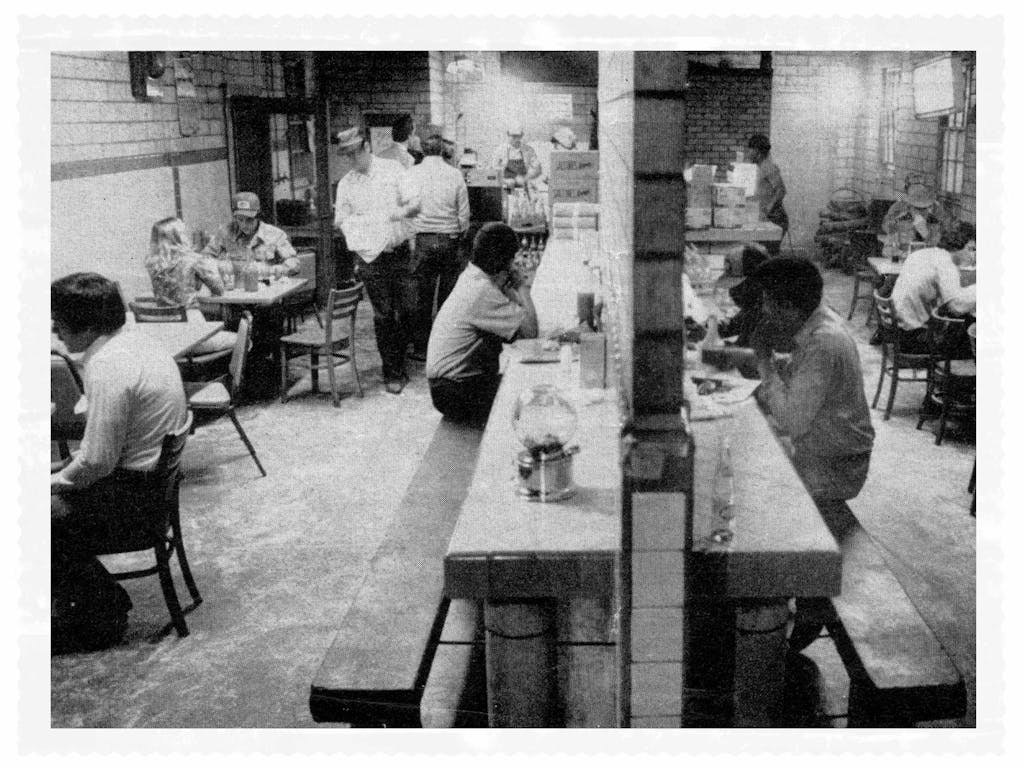
DV: Was the original wall there to divide the dining room during segregation?
BB: Exactly. When my grandfather bought it in 1968 the wall was there, but none of the signs were left. Even without the signs there were customers who would come in and only eat on certain sides.
DV: Was the barbecue ordered from the meat counter in those days?
BB: No. It was actually ordered form a separate barbecue counter. You walked right up to the pit to tell them what you wanted. You had to walk through the meat market and down a hallway to the back of the building to get there. It was an afterthought. The goal was to sell the meat fresh. After the fire the pit was separated from the dining room with a wall. It was really done as a way to conserve electricity for the air conditioning.
DV: What was the menu like back then?
BB: I’m not sure. I was born in ’75 so I’ve been hanging around since then. From my early memory it was always sausage, brisket, and pork ribs. I remember them adding half chickens at some point. I remember hearing my grandfather, who was a meat salesman out of San Antonio, saying he didn’t sell briskets to these little barbecue joints. It was all sides or bone-in chucks once they got into boxed beef.
DV: Do you have any old photos of the interior?
BB: We do. There’s one of Lee Wilson in 1927. It’s him and his folks standing in front of the meat counter.
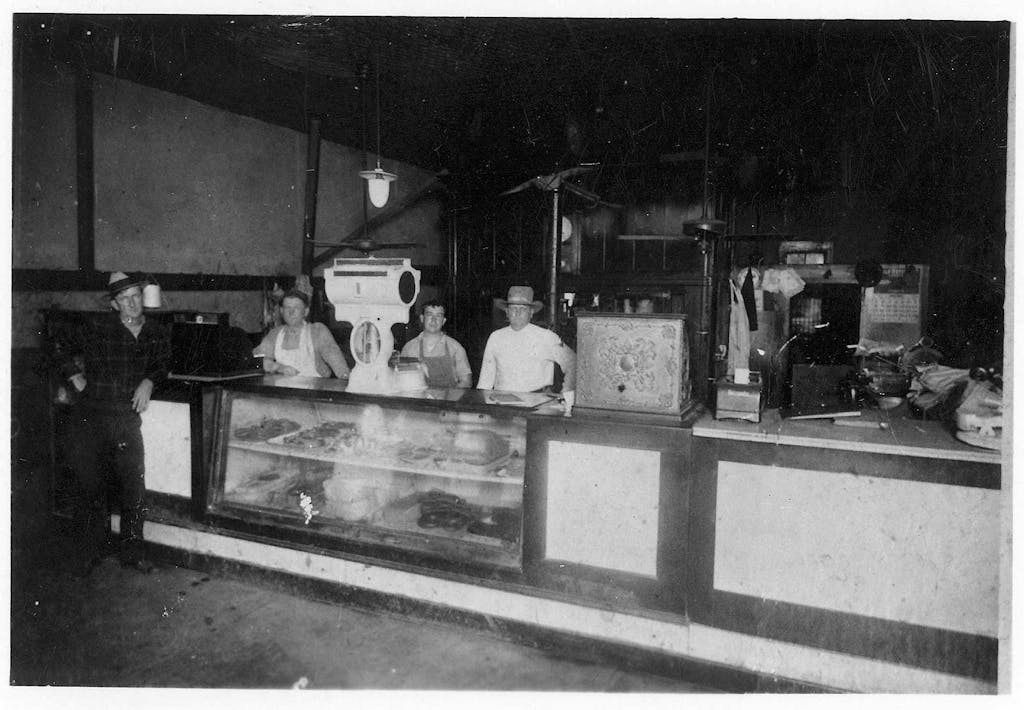
DV: Your menu is a lot wider than just brisket, ribs, and sausage now.
BB: Some people treat sausage as a side, but it’s still the center of the plate for us. We like using brisket instead of clods and spare ribs instead of St. Louis style ribs. In the late nineties we added baby back ribs. We also have pork steaks which are slices of pork shoulder that we smoke.
DV: I didn’t know you had pork steaks on the menu. That’s one of my favorite things to get when I go to Snow’s BBQ.
BB: Kerry at Snow’s needs to give me some credit for that one. When he was starting Snow’s he came in and wanted to set up a wholesale account for meat. In the beginning he bought sausage from us too. He asked me about what other things to put on the menu and I suggested pork steaks.
DV: That Snow’s pork steak is pretty famous, and he owes it all to you?
BB: Well, they still have to cook it. I’m just sad that we sent him on down the road with some meat and he goes and gets more famous than us [laughing]. Heck.
DV: So Southside is still a functioning butcher shop. The meat case isn’t just for show?
BB: No doubt. We don’t compete with big box grocery stores. We don’t have chucks and rump roasts or hamburger, but we carry everything that we have on the barbecue menu. Whatever it is, it sits in the butcher case for one day. It gets seasoned and we try to sell it seasoned the next day. If it doesn’t sell, it goes on the barbecue pit.
DV: Do you normally season all the barbecue the day before it goes on?
BB: Exactly.
DV: What do you season it with?
BB: Up until the early 2000’s it was just salt and pepper. We had to throw in some orange stuff to throw people off like you and Robb Walsh who come sneaking around.
DV: Can you tell us the sausage recipe?
BB: Not really. It’s all beef. Take me on a good deer hunt and you might get it in a moment of weakness. One day I wanted to go on a hunting trip. We were mixing the spices ourselves back then. I made a big batch of seasoning, but I wanted to make sure I wasn’t bothered during the trip. I went to give the sausage recipe to my wife in case we ran out of spices. She wouldn’t take it. She didn’t want to know the recipe.
DV: How many people know the recipe?
BB: My dad and I and the company that mixes our spices for us. I will not tell you who they are.
DV: Do you still experiment with other flavors?
BB: Our first 125 years we had one sausage recipe. Now we distribute our sausage to grocery stores. We wanted more shelf space, so we needed more flavors of sausage. At that time in ’07 and ’08 beef prices were kicking our butt. When the beef prices went up we really suffered, so I developed a pork sausage and a pork and beef mix. The reality is that we’re in Texas and people eat beef. We have a tougher time selling pork sausage.
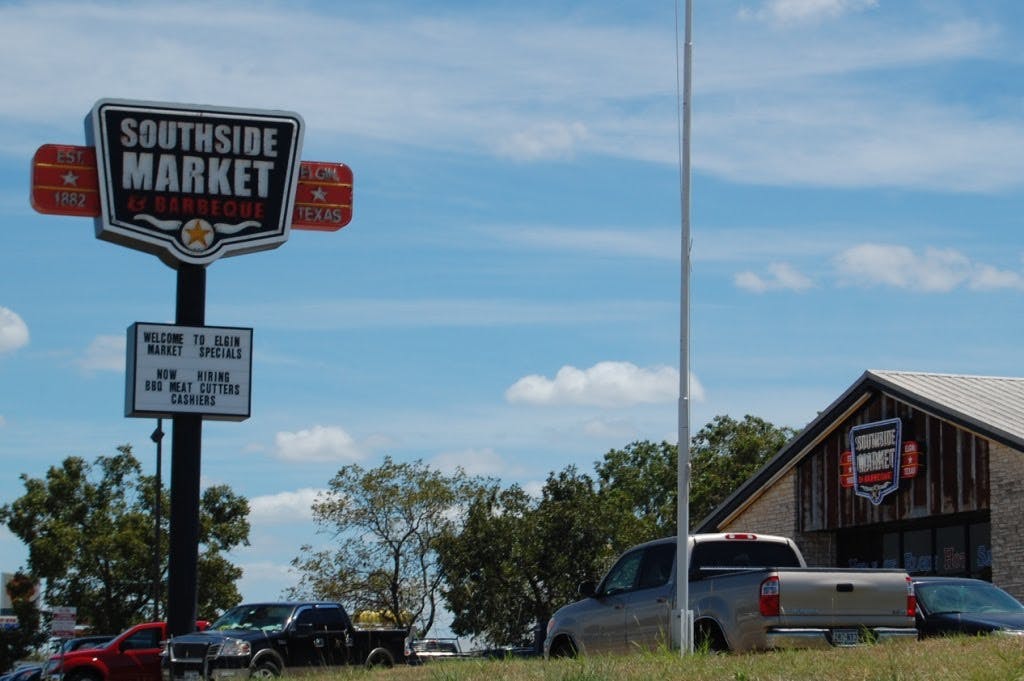
DV: Is there another generation in training to take over when you’re through?
BB: Yes. I’ve got twin boys that are eight. I had them both here at Barbecue Summer Camp last year. In a family business your retirement plan is to have kids early. My parents had me when they were twenty. I waited until I was thirty to have kids. There’s no pressure on them, but they’ve got it in their blood.
DV: There must be plenty of pressure on you. You’re carrying the family legacy and running the oldest barbecue joint in Texas. Is that something you ever think about?
BB: I don’t know any different. I just get up and do what I do. There’s pressure when you start dealing with balance sheets and bankers, but I don’t let myself read too many magazines or blogs. It eats at me if I don’t feel like I’m on top of my game. We don’t wake up every morning to be in second place.
DV: What is your measuring stick for success?
BB: We call them B.I.D.’s. Butts in the door. I’m a spreadsheet guy, so we track that from year to year. If we don’t beat the same weekend last year then something’s wrong. We’ve got to make a profit. We have eighty-five employees. I’m watching that ship.
DV: When was the last time your primary job was cooking meat?
BB: I actually started cleaning tables. Then I popped the top off of Big Red soda bottles. They didn’t screw off back then so you had to pop the top off and hand it to the customer. Big Red outsold everyone else. By the end of the day your shirt from the wrist to the elbow was stained red. By the time I was thirteen or fourteen I was back in the pits learning. Once I got my degree I wasn’t in the pits anymore. I was being trained to run the plant.
DV: Did you always want to go back to Southside, or was there a time when you were sick of sausage and barbecue?
BB: I don’t ever remember making a life decision. I just always knew that’s what I was going to do. I tailored my college curriculum around what would help out at Southside. When I got back to Elgin I thought I was big stuff with my ring and my diploma. The first thing my dad and grandpa gave me was the keys to the forklift and no raise in pay. I was thinking “what the hell? I just went to school for four years to run a forklift?”
DV: How did the transition happen from the forklift to running the place?
BB: I wasn’t exactly knighted. In a family business pats on the back are few and far between, but my first pat on the back is when grandpa started going home early. I knew I must be doing something right. The same thing started happening with my dad. I looked up one day and employees were coming to me and asking about making decisions. In the beginning I would relay those questions to the powers that be, but that political process didn’t work so well. It became better to beg for forgiveness than ask permission.
DV: There must have been some formal paperwork to make that happen.
BB: There were three generations in a room and I was the pesky grandson asking what was going to happen to the business. It was very uncomfortable in the beginning, but there are some pretty famous barbecue places where that transition didn’t work out so smoothly. I got with my dad and asked if he wanted to partner up and buy the place. He said yes and told me to go talk to my grandparents. I went over there and we sat down. When you’re at my grandparents house, no matter the time of day, you have to have a cup of coffee. I remember I asked my grandfather if he’d ever consider selling this place to me and my dad. The first time I asked he said yes. Seven years later we finally signed the closing papers. In November of 2010 my wife and I bought the place. We’re partners with my parents, but for all intents and purposes we run the place. Nobody else in the family works there on a daily basis.
DV: Was there ever a point where you had to tell your dad to just let you do your thing? Was there any sort of blow-up?
BB: It never got to gunplay. The whole ownership agreement is just paperwork. Since I was there cleaning tables as a seven-year-old, it always felt like mine.







